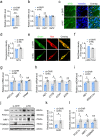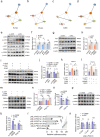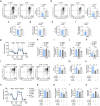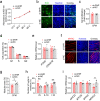Local GHR roles in regulation of mitochondrial function through mitochondrial biogenesis during myoblast differentiation
- PMID: 37337300
- PMCID: PMC10278349
- DOI: 10.1186/s12964-023-01166-5
Local GHR roles in regulation of mitochondrial function through mitochondrial biogenesis during myoblast differentiation
Abstract
Background: Myoblast differentiation requires metabolic reprogramming driven by increased mitochondrial biogenesis and oxidative phosphorylation. The canonical GH-GHR-IGFs axis in liver exhibits a great complexity in response to somatic growth. However, the underlying mechanism of whether local GHR acts as a control valve to regulate mitochondrial function through mitochondrial biogenesis during myoblast differentiation remains unknown.
Methods: We manipulated the GHR expression in chicken primary myoblast to investigate its roles in mitochondrial biogenesis and function during myoblast differentiation.
Results: We reported that GHR is induced during myoblast differentiation. Local GHR promoted mitochondrial biogenesis during myoblast differentiation, as determined by the fluorescence intensity of Mito-Tracker Green staining and MitoTimer reporter system, the expression of mitochondrial biogenesis markers (PGC1α, NRF1, TFAM) and mtDNA encoded gene (ND1, CYTB, COX1, ATP6), as well as mtDNA content. Consistently, local GHR enhanced mitochondrial function during myoblast differentiation, as determined by the oxygen consumption rate, mitochondrial membrane potential, ATP level and ROS production. We next revealed that the regulation of mitochondrial biogenesis and function by GHR depends on IGF1. In terms of the underlying mechanism, we demonstrated that IGF1 regulates mitochondrial biogenesis via PI3K/AKT/CREB pathway. Additionally, GHR knockdown repressed myoblast differentiation.
Conclusions: In conclusion, our data corroborate that local GHR acts as a control valve to enhance mitochondrial function by promoting mitochondrial biogenesis via IGF1-PI3K/AKT/CREB pathway during myoblast differentiation. Video Abstract.
Keywords: GHR; IGF1; Mitochondrial biogenesis; Mitochondrial function; Myoblast differentiation.
© 2023. The Author(s).
Conflict of interest statement
The authors declare that they have no competing interests.
Figures







Similar articles
-
METTL3-dependent m6A modification of GHR mRNA regulates mitochondrial function through mitochondrial biogenesis during myoblast differentiation.Poult Sci. 2025 Jul;104(7):105216. doi: 10.1016/j.psj.2025.105216. Epub 2025 Apr 25. Poult Sci. 2025. PMID: 40344709 Free PMC article.
-
IGF2 promotes the differentiation of chicken embryonic myoblast by regulating mitochondrial remodeling.J Cell Physiol. 2024 Sep;239(9):e31351. doi: 10.1002/jcp.31351. Epub 2024 Jun 30. J Cell Physiol. 2024. PMID: 38946060
-
Roles of chicken growth hormone receptor antisense transcript in chicken muscle development and myoblast differentiation.Poult Sci. 2019 Dec 1;98(12):6980-6988. doi: 10.3382/ps/pez416. Poult Sci. 2019. PMID: 31376348 Free PMC article.
-
A Balanced Act: The Effects of GH-GHR-IGF1 Axis on Mitochondrial Function.Front Cell Dev Biol. 2021 Mar 18;9:630248. doi: 10.3389/fcell.2021.630248. eCollection 2021. Front Cell Dev Biol. 2021. PMID: 33816476 Free PMC article. Review.
-
Regulation of mitochondrial biogenesis through TFAM-mitochondrial DNA interactions: Useful insights from aging and calorie restriction studies.Mitochondrion. 2015 Nov;25:67-75. doi: 10.1016/j.mito.2015.10.001. Epub 2015 Oct 3. Mitochondrion. 2015. PMID: 26437364 Review.
Cited by
-
dVGLUT Is a Mediator of Sex Differences in Dopamine Neuron Mitochondrial Function Across Aging and in a Parkinson's Disease Model.Aging Cell. 2025 Aug;24(8):e70096. doi: 10.1111/acel.70096. Epub 2025 May 12. Aging Cell. 2025. PMID: 40354193 Free PMC article.
-
Circular RNA circ_0022707 impedes the progression of preeclampsia via the miR-3135b/GHR/PI3K/Akt axis.Funct Integr Genomics. 2024 Nov 5;24(6):208. doi: 10.1007/s10142-024-01490-0. Funct Integr Genomics. 2024. PMID: 39499344
-
EI24 binds to IGF1R, enhancing glucose homeostasis and fostering healthy aging in male mice.Front Aging. 2025 Jun 10;6:1564730. doi: 10.3389/fragi.2025.1564730. eCollection 2025. Front Aging. 2025. PMID: 40556865 Free PMC article.
-
METTL3-dependent m6A modification of GHR mRNA regulates mitochondrial function through mitochondrial biogenesis during myoblast differentiation.Poult Sci. 2025 Jul;104(7):105216. doi: 10.1016/j.psj.2025.105216. Epub 2025 Apr 25. Poult Sci. 2025. PMID: 40344709 Free PMC article.
References
-
- Hayashi AA, Proud CG. The rapid activation of protein synthesis by growth hormone requires signaling through mTOR. Am J Physiol-Endoc M. 2007;292:E1647–E1655. - PubMed
Publication types
MeSH terms
Substances
LinkOut - more resources
Full Text Sources
Research Materials
Miscellaneous

